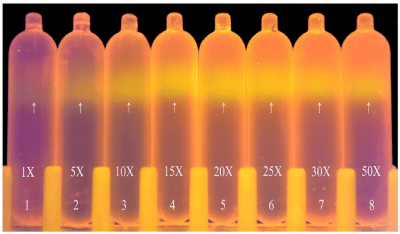Content #1
Content #1
Content #1
Cesium chloride (CsCl) centrifugation is used to fractionate DNA based on density. When a solution of CsCl is centrifuged at high speeds, it forms a linear density gradient. DNA in the solution separates into bands based on its density. The inclusion of fluorescent DNA dye in the solution allows the bands to be visualized for needle extraction from the centrifuge tube. Typically, ethidium bromide (EtBr) is used in CsCl gradients to detect bands. EtBr is not only toxic and mutagenic, but also requires UV excitation for detection, which results in damage to the DNA sample and carries the risk of skin and eye burns from UV irradiation.
In a new study in PLoS One, Gao and colleagues report the usefulness of GelGreen™ Nucleic Acid Gel Stain for CsCl fractionation of DNA. GelGreen™ is a non-toxic, non-mutagenic green fluorescent DNA dye that is widely used for agarose gel staining, but which has not been shown to work in CsCl gradients before. The study showed that GelGreen™ was 3X more sensitive and required less dye than SYBR® Safe in CsCl gradients. GelGreen™ allowed detection of as little as 0.2 ug of DNA from environmental samples, and was compatible with needle extraction and downstream PCR analysis of the fractionated DNA. In addition, GelGreen™ could be visualized using visible blue LED light, which does not damage DNA or cause burns, unlike UV lamps.
To read the original article, click here.
Gao J, Pan K, Li H, Fan X, Sun L, Zhang S, et al. (2017) Application of GelGreen™ in Cesium Chloride Density Gradients for DNA-Stable Isotope Probing Experiments. PLoS ONE 12(1): e0169554. doi:10.1371/journal.pone.0169554

To learn more about the safe and sensitive DNA gel stains GelGreen™ and GelRed™, click here.